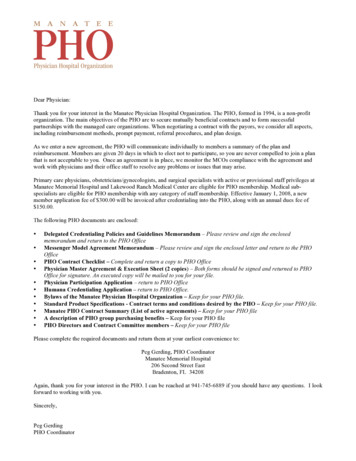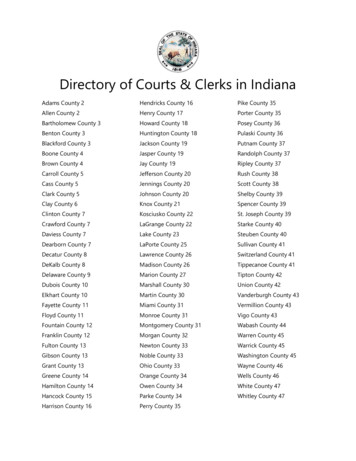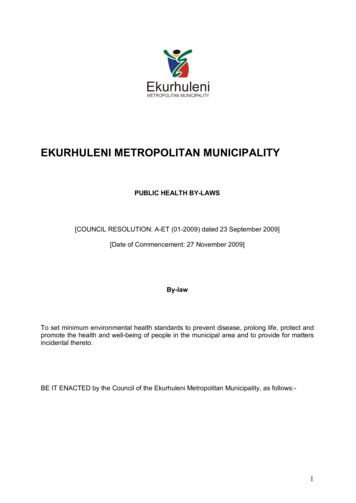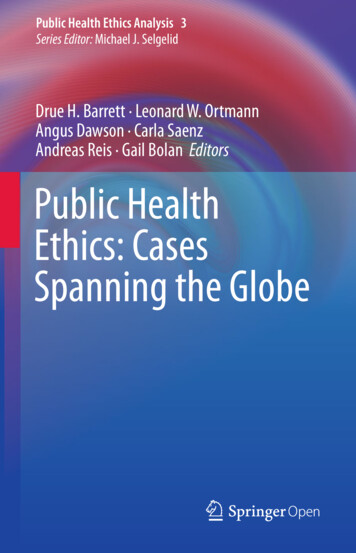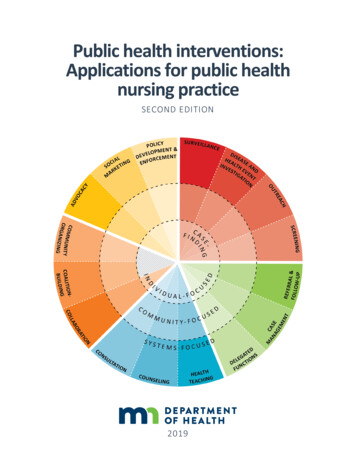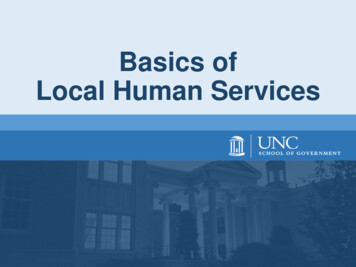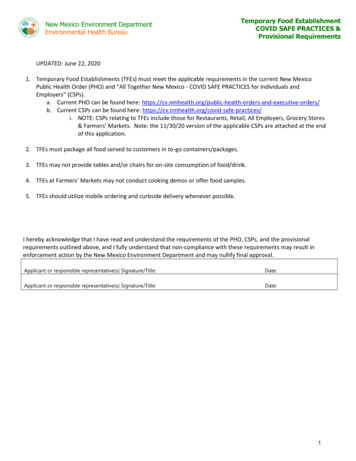
Transcription
New Mexico Environment DepartmentEnvironmental Health BureauTemporary Food EstablishmentCOVID SAFE PRACTICES &Provisional RequirementsUPDATED: June 22, 20201. Temporary Food Establishments (TFEs) must meet the applicable requirements in the current New MexicoPublic Health Order (PHO) and “All Together New Mexico - COVID SAFE PRACTICES for Individuals andEmployers” (CSPs).a. Current PHO can be found here: xecutive-orders/b. Current CSPs can be found here: https://cv.nmhealth.org/covid-safe-practices/i. NOTE: CSPs relating to TFEs include those for Restaurants, Retail, All Employers, Grocery Stores& Farmers’ Markets. Note: the 11/30/20 version of the applicable CSPs are attached at the endof this application.2. TFEs must package all food served to customers in to-go containers/packages.3. TFEs may not provide tables and/or chairs for on-site consumption of food/drink.4. TFEs at Farmers’ Markets may not conduct cooking demos or offer food samples.5. TFEs should utilize mobile ordering and curbside delivery whenever possible.I hereby acknowledge that I have read and understand the requirements of the PHO, CSPs, and the provisionalrequirements outlined above, and I fully understand that non-compliance with these requirements may result inenforcement action by the New Mexico Environment Department and may nullify final approval.Applicant or responsible representative(s) Signature/Title:Date:Applicant or responsible representative(s) Signature/Title:Date:1
New Mexico Environment DepartmentEnvironmental Health BureauApplication Date:Name of owner/operator:Application for Permit to OperateTemporary Food Establishment (TFE)Section 1 - Operator InformationCell:Phone:City:Mailing address:Email:Name of on-site person-in-charge:State:Zip:Phone:(Provide copy of food handler card or certified manager certificate)Section 2 - Temporary Food Event InformationAddress/Location:Name of booth:Name of event:Date(s) of eventStart date:Event organizer:Indoor event City:End date:Set-up time:Organizer phone:Event locationOutdoor event State:Time(s) of eventOpen time:Zip:Close time:Facility typeBooth Permanent building Mobile Push cart For sections 3-10 (below) please refer to attached Chart 10-1 for TFE requirementsMenu itemSection 3 - MenuPlace of purchasePreparedPrepared on-site at TFE Prepared at other location** Sold commercially prepackaged Prepared on-site at TFE Prepared at other location** Sold commercially prepackaged Prepared on-site at TFE Prepared at other location** Sold commercially prepackaged Prepared on-site at TFE Prepared at other location** Sold commercially prepackaged Prepared on-site at TFE Prepared at other location** Sold commercially prepackaged Prepared on-site at TFE Prepared at other location** Sold commercially prepackaged (Additional menu items may be attached to this application)** Food menu item prepared at other locations complete the followingName of establishment:Type of establishment:Permit holder name:Permit #:(Additional locations for preparation of food items may be attached to this application)Overhead covering:Example: CanopyEstablishment phone:Section 4 - Booth ConstructionFloor:Walls:AsphaltTemporary Food Establishment Application 03212016 Final Rev 03Screens with ability to cover solid1
New Mexico Environment DepartmentEnvironmental Health BureauApplication for Permit to OperateTemporary Food Establishment (TFE)Section 5 - Handwashing Set-upType of handwashing:(Hand soap, paper towels and trashcan must be provided at all set-ups)How will water be heated:Bare hand contact eliminated by:(check all that apply)Container with on/off spigotAuxiliary heating source (i.e. burner) Dispensingunits Deli tissue and catch bucket Water heater Portable handwashing sink Other Utensils Gloves Handwashing sink w/ hot & coldOther:running water under pressure Section 6 - Utensil Washing Set-up(Must wash with soap, rinse with water and sanitize all utensils/dishes)Method of utensil washing:How will water be heated:3 Basins (i.e. bus tub) 3 Compartment sink 3 Compartment sink w/ hot& cold running water underpressure Auxiliary heating source (i.e. burner) Water heater Other:Type of sanitizer:(select)Chlorine (bleach) Quaternary ammonia Iodine (Concentration)PPMPPMPPM(Appropriate test-strips required)Section 7 - Utility Supply and DisposalWater sourceWaste water disposalPower SupplyTrash disposalExample: City waterWastewater containers provided byorganizerGeneratorDumpsters availableSection 8 - EquipmentUse:Type:(Use additional sheets if needed)Certification: (examples include: NSF, ETL)Transportation to eventhot/cold foods(Example: Insulated container, cooler, etc.)Cold holding(Example: Refrigeration, prep table, etc.)Hot holding(Example: Steam table, grill etc.)Cooking/ Re-heating(Example: Grill, stove, burners etc.)Food thermometers(Example: Metal Stem 0-220⁰F)OtherTemporary Food Establishment Application 03212016 Final Rev 032
New Mexico Environment DepartmentEnvironmental Health BureauApplication for Permit to OperateTemporary Food Establishment (TFE)Section 9 - Food Preparation(Use additional sheets if needed)Food(List all menu items)EXAMPLE:HamburgersThawCut/WashCold HoldingWhere?Where?Where?How?No thawing,cooked from frozenAssembleNone, usingpreformedpattiesHow?CookHow?Where?Hot HoldingHow?Where?ReheatingHow?In cooler with ice Patties are cooked Burgers areBurgers that falloncoveredgrilltoobelow 41 Fplaced in beef below 135oF reheated165oFbroth and heldon grill to 165oFon covered grillat 135oFTemporary Food Establishment Application 03212016 Final Rev 033
New Mexico Environment DepartmentEnvironmental Health BureauApplication for Permit to OperateTemporary Food Establishment (TFE)Section 10 - TFE Floor PlanIn the following space, provide a drawing of the TFE. Identify and describe all equipment includingcooking and hot/cold holding equipment, handwashing facilities, worktables, dishwashing facilities, foodand utensil storage, garbage containers, and customer service areas.Draw your sketch hereExampleFloor Plan (view from top)STATEMENT: I hereby certify that the above information is correct, and I fully understand that any deviation from theabove without prior permission from the State of New Mexico Environment Department may nullify final approval. Iagree to comply with 7.6.2 NMAC -- Food Service And Food Processing Regulations and allow the regulatory authorityaccess to the establishment and records.Applicant or responsible representative(s) Signature/TitleDateApplicant or responsible representative(s) Signature/TitleDateApproved Approved with conditions* Denied** NMED use onlyTFE category:Type 1 Type 2 Type 3 Signature/Title:Date:Permit #:Permit fee required: Yes No Permit fee received: Yes No Date:*Conditions of approval:**Reasons for denial:Temporary Food Establishment Application 03212016 Final Rev 034
New Mexico Environment DepartmentEnvironmental Health Cold holding(e.g., preptable, displaycase)Hot holdingCooking/reheatingFlooringApplication for Permit to OperateTemporary Food Establishment (TFE)Chart 10-1Type 1Type 2-unpackaged non-TCS***-no cook (receive-store-minimum-commercially processed packagedprep*-hold-serve)-same day prep (receive-storeTCS*** in original package (receiveminimum prep*-cook-holdstore-hold)serve)-reheat commercially processed(receive-store-reheat-hold-serve)gravity fedsame as Type 1 4 hrs. - insulated container or auxiliaryheating source 4 hrs. - auxiliary heating sourceunpackaged non-TCSsame as Type 1 unpackaged non 4 hrs. - 3-comp or extra utensilsTCS 4 hrs. - 3-comp requiredpackaged TCS: not requiredunpackaged non-TCS: not requiredsame as Type 1 packaged TCSpackaged TCS: 1 day - insulated ice chest w/drainedice2-3 days - mechanical equipment 3 days - mechanical ANSI equipmentonlyunpackaged non-TCS: not requiredsame as Type 1 packaged TCSpackaged TCS:-ice bath-2-3 days - mechanical equipmentrecommended- 3 days - mechanical ANSI equipmentrecommendednot allowedcovered non-ANSI equipmentallowed**not allowedcovered non-ANSI equipmentallowed**grass; smooth, durable, easily cleanable 2 days - same as Type 1such as: concrete, machine-laid asphalt, 2 days - same as Type 1, noSealed wood, tile, impermeable tarpgrassWallsunpackaged non-TCS 3 days - no sides, ability to cover solid 3 days - 3.5 side screening, ability tocover solidpackaged TCS: not requiredTrainingas required by regulatory authority 1 day - no sides, ability tocover solid1 to 3 days - 3.5 side screening,ability to cover solid 3 days - complete enclosurew/approved openingas required by regulatoryauthorityType 3-complex food prep (receivestore-prep-cook-coolreheat-hot hold-serve)OR serving highly susceptiblepopulationhot & cold running waterunder pressure3-comp required w/ hot &cold running water underpressuremechanical ANSI equipmentonlysame as Type 1 packagedTCScovered ANSI equipmentonlycovered ANSI equipmentonly 3 days - same as Type 1,no grass 3 days - constructedflooringcomplete enclosurew/approved openingCertified food protectionmanager required*Minimum preparation includes activities such as: slicing/cutting fruits and vegetables, opening commercially PACKAGED TIME/TEMPERATURE CONTROL FOR SAFETY FOOD, and seasoning TIME/TEMPERATURE CONTROL FOR SAFETY FOOD. Minimum preparationdoes not include activities such as: cutting, slicing, or forming raw MEAT, POULTRY, or FISH; assembly of complex menu items.**Chafing dishes may be allowed for events of 4 hours or less. Insulated ice chests and slow cookers are not allowed for hot holding. Slowcookers are not allowed for heating, cooking, or reheating.*** “TCS” means “Time/Temperature Control for Safety Food”. See definition on page 21 of the Retail Food Field Guide for details.5Temporary Food Establishment Application 03212016 Final Rev 03
COVID-SAFE PRACTICES FORALL EMPLOYERSOur businesses leaders have shown great determination and leadership in the face of the extraordinaryhardship caused by COVID-19. As the economy reopens, we are asking for your help to ensure all NewMexicans—your customers, employees, and families—take precautions to remain safe when enteringa place of business. Please help us set the highest standards for living with COVID-19 by enacting theserequirements and additional best practices.Required Limit operations to remote work to the greatest extent possible. Arrange workplace to provide for 6 feet of distance between individuals wherever possible. Close common areas where personnel are likely to congregate wherever possible or modify them tominimize contact. Provide for all meetings to take place remotely whenever possible. Ensure all employees have face coverings or masks and wear them in the workplace at all times whenin the presence of others, except when eating or drinking, or unless otherwise advised bya health care provider. Train all employees on daily cleaning and disinfecting protocol, hygiene, and respiratory etiquette(e.g., covering coughs). Make handwashing, sanitizer, and other hygiene support available to employees.Note: the use of gloves is not a substitute for frequent handwashing. Screen employees before they enter the workplace each day (verbally or with a written form or textbased or other app). Send employees home who are experiencing the following COVID-19 symptomsrelated to COVID-19 and direct them to obtain free testing through the Department of Health. Fever Sore throat Chills Cough Headache Repeated shaking with chills Shortness of breath Muscle pain Loss of taste or smellALL TOGETHER NEW MEXICO:CSPs FOR INDIVIDUALS & EMPLOYERSNOVEMBER 30, 20209
COVID-SAFE PRACTICES FOR ALL EMPLOYERS Prohibit employees with known close contact to a person who is lab-confirmed to have COVID-19 toreturn to work until authorized by the Department of Health. Minimize non-essential travel. Adhere to CDC guidelines and state orders regarding isolation followingout-of-state travel. Adhere to all CDC and OSHA guidelines.Best Practices Develop a COVID-19 communication plan and provide a forum for answering employee questions andaddressing concerns. Appoint a COVID-Safe Practice leader or team to enact safe practices in the workplace. Review employee leave policies and modify as needed to ensure compliance with the Families FirstCoronavirus Response Act. Consider assigning vulnerable workers duties that minimize their contact with customers and otheremployees (e.g., managing inventory rather than working as a cashier, managing administrative needsthrough telework). To support contract tracing, offer all customers who visit the establishment with the opportunity torecord their name and phone number or email address, along with the date and time of their visit, andretain such records for no less than four weeks from the date of collection. Follow all heating, ventilation and air conditioning (HVAC) preventative maintenance as required bythe manufacturer on prescribed schedules. When possible, consult with an HVAC engineer to improveventilation and minimize the potential for worker exposure.Additional Resources Occupational Safety and Health Administration (OSHA): Guidance on Preparing Workplaces forCOVID-19 CDC: Guidelines for Cleaning and Disinfection Community Facilities Environmental Protection Agency (EPA): List N: Disinfectants for Use Against SARS-CoV-2 CDC Print Resources in multiple languages CDC Frequently Asked Questions CDC General Business FAQ COVID-19 Emergency Supply CollaborativeALL TOGETHER NEW MEXICO:CSPs FOR INDIVIDUALS & EMPLOYERSNOVEMBER 30, 202010
COVID-SAFE PRACTICES:RETAILRetail establishments providing essential goods and services have remained open in limited capacitiesduring the public health emergency, requiring their courageous employees to be on the front lines.We’ve learned important lessons below from these businesses and employees on how to keep safewhile servicing customers, which are embodied in the requirements and best practices below.Required Adhere to Required COVID-Safe Practices for All Employers (p. 9). Adhere to maximum occupancy limits per the State’s Public Health Order. Utilize signs, stanchions and/or floor decals to support 6-foot social distancing, including one-way aisletraffic and separate entry/exit wherever possible. Utilize signage to communicate occupancy limits and encourage customers to wear face coverings. Maintain a schedule of stringent daily cleaning and sanitizing. Once every two hours (or more frequently), clean and disinfect high-touch items such as doors, fittingrooms and credit card terminals. Establish safety protocols to allow for contactless curbside pickup and home delivery wherever possible.Best Practices Employ a greeter to communicate safety restrictions and protocols. Install large plexiglass sneeze guards at cash registers wherever possible. Arrange for contactless payment and receipt options to the greatest extent possible. Screen employees and customers with a no-contact thermometer; individuals with a temperaturereading above 100.4 F should be denied entry. Offer face coverings and gloves to customers. Provide alternative shopping times to vulnerable individuals at higher risk of severe illness.ALL TOGETHER NEW MEXICO:CSPs FOR INDIVIDUALS & EMPLOYERSNOVEMBER 30, 202011
COVID-SAFE PRACTICES:RESTAURANTSBefore COVID-19, restaurants and food service employees kept our restaurants clean and food safe forcustomers. They are doing the same now, plus enhanced work practices recommended by the Food andDrug Administration and the Centers for Disease Control and Prevention.When permitted by the State’s Public Health Order, restaurants will be allowed to offer dine-in serviceunder the following requirements.Required Adhere to Required COVID-Safe Practices for All Employers (p. 9). Adhere to Required COVID-Safe Practices for Retail Establishments (p. 11). Discontinue service stations that require customers to congregate in certain areas or use commonutensils/dispensers, including salad bars, buffets and beverage and coffee stations. Comply with state Public Health Order limitations on bar and counter seating and non-seated service;and, if otherwise permitted, ensure that six feet or more distance is maintained between customers. Establishments that serve alcohol must adhere to required closing time, if applicable, for per the PublicHealth Order. Reservations and private events may not exceed the mass gathering definition and limit per the PublicHealth Order. Ensure patrons are seated at all times. Activities that require standing and congregating are prohibited,including gaming areas, sports and recreational activities, dance floors, bar games, karaoke, and othersuch activities. Live performances may not be ticketed events. Performers must wear masks at all times and maintainsocial distancing from other performers and patrons. Patrons must remain seated. Live performancesdo not include karaoke, which is prohibited. Employees that handle items used or provided by customers must properly wash their hands or changegloves before serving another customer (e.g. tableware, cutlery, glasses, credit cards, cash, pens, etc.). Discontinue allowing pets, excluding service animals, inside the establishment, onto patios, into storesor other such areas. Clean and sanitize reusable items such as menus and condiment containers left on tables after eachuse. If items cannot be cleaned and sanitized after each use, offer single-use items.ALL TOGETHER NEW MEXICO:CSPs FOR INDIVIDUALS & EMPLOYERSNOVEMBER 30, 202012
COVID-SAFE PRACTICES: RESTAURANTS To support contract tracing, provide all customers who visit the establishment the opportunity to recordtheir name and phone number or email address, along with the date and time of their visit, and retainsuch records for no less than four weeks from the date of collection.Additional Requirements for Outdoor Dining Modifications Expansions of outdoor service areas must be approved by the appropriate local government agency. Ifservice includes a liquor licensed premises, complete an application for approval through the Alcoholand Beverages Control (ABC) Division, which can be found on their website (rld.state.nm.us/abc). The area must be open on at least three sides when in use for outdoor dining. Tent sidewalls may beadded for security when the facility is not in use. Tents may be utilized if approved by the appropriate local government agency. Opening a garage door or all windows does not constitute an outdoor dining area. Per the Fire Code, open flame or other devices emitting flame, fire or heat or any flammable orcombustible liquids, gas, charcoal or other cooking device or any other unapproved devices shall not bepermitted inside or located within 20 feet of the tent or membrane structures while open to the publicunless approved by the relevant Fire Code Official.Additional Requirements for Indoor DiningIn order to operate indoor dine-in service, restaurants must adhere to the following additional measures: Become New Mexico Safe Certified in Restaurants. To enroll in the program, please visit: nmsafecertified.org. Employees must be retrained within 3 calendar days of any changes to COVID-Safe Practices. Maintain contact tracing records for no less than 21 calendar days by recording the date and time,name(s), phone number(s) and email address(es) of all customers who dine on premises (indoor andoutdoor). This information must be made available upon the request of the NM Department of Health. Screen all employees before they enter the workplace and send employees home who are experiencingCOVID symptoms. Allow and coordinate with the New Mexico Department of Health and/or the NewMexico National Guard to test symptomatic employees.ALL TOGETHER NEW MEXICO:CSPs FOR INDIVIDUALS & EMPLOYERSNOVEMBER 30, 202013
COVID-SAFE PRACTICES: RESTAURANTS Screen all customers as they enter the premises utilizing a COVID questionnaire outlined below (verballyor with a written form). Customers who report COVID symptoms or answer affirmatively to any of thefollowing questions should be denied service. Restaurants are not required to retain health screeninginformation. Have you been directly exposed to someone under investigation for, or with a confirmed case of,COVID-19 in the past 14 days? Have you experienced any of the following symptoms today, unrelated to a chronic and/or preexisting condition? (select all that apply)»Fever (100.4 degrees or greater)»Cough (unrelated to seasonal allergies or asthma)»Shortness of Breath (unrelated to seasonal allergies or asthma)»Loss of taste or smell»GI symptoms (vomit, nausea or diarrhea) (unrelated to a chronic condition)»Chills»Shaking chills, otherwise known as rigors»Headache»Muscle pain»Sore throat»Fatigue»Congestion or runny nose (unrelated to seasonal allergies)»None Have you been contacted by the NM Department of Health and/or placed under self-quarantinefor COVID-19 for any reason? Have you tested positive for COVID-19 in the past 14 days? Have you traveled to another state or country in the past 14 days? Have any members of your household traveled to another state or country in the past 14 days? Have you, or a member of your household, traveled by sea (Domestic or International) within thepast 14 days?ALL TOGETHER NEW MEXICO:CSPs FOR INDIVIDUALS & EMPLOYERSNOVEMBER 30, 202014
COVID-SAFE PRACTICES: RESTAURANTSBest Practices Consider accepting customers on a reservation-only basis. When scheduling staff to cover shifts, consider additional breaks to provide for frequent handwashing,more frequent and longer time frames to sanitize equipment, etc. Provide single-use items such as plates, cutlery, and napkins to customers and do not leave them incommon areas or on tables for self-service. Install large plexiglass sneeze guards at cash registers wherever possible. Arrange for contactless payment and receipt options to the greatest extent possible. Screen employees and customers with a no-contact thermometer; individuals with a temperaturereading above 100.4 F should be denied entry.Additional Resources Food and Drug Administration: Best Practices for Retail Food Stores, Restaurants, and Food Pick-Up/Delivery Services During the COVID-19 Pandemic New Mexico Food Establishment Reopening Checklist New Mexico Food Program New Mexico Restaurant AssociationALL TOGETHER NEW MEXICO:CSPs FOR INDIVIDUALS & EMPLOYERSNOVEMBER 30, 202015
COVID-SAFE PRACTICES:GROCERY STORES & FARMERS’ MARKETSBefore COVID-19, grocery store and farmers’ market employees kept these establishments clean and foodsafe for customers. They are doing the same now, plus enhanced work practices recommended by the Foodand Drug Administration and the Centers for Disease Control.Required Adhere to Required COVID-Safe Practices for All Employers (p. 9). Adhere to Required COVID-Safe Practices for Retail Establishments (p. 11). Adhere to maximum occupancy limits per the State’s Public Health Order. If food service is provided onsite, adhere to COVID-Safe Practices for Restaurants (p. 12) Discontinue service stations that require customers to congregate in certain areas or use commonutensils/dispensers, including food samples, bulk bins, beverage stations, etc. Prohibit the refilling of customer-supplied, reusable containers (e.g. coffee cups and water bottles). Require customers who bring reusable bags to bag their own purchases. Clean and sanitize equipment, including pallet jacks, ladders and supply carts, between each use. For deliveries: Temporarily suspend truck drivers from entering the sales floor unless as a customer or to usethe restroom. Arrange for contactless signatures for deliveries. Expand store delivery times to spread out deliveries and prevent overcrowding. Vendors required to enter the business must follow employee protocols for personal protectiveequipment and social distancing.Additional Requirements for Farmers’ Markets Farmers, vendors, market staff and volunteers must wear food grade gloves, with frequent changesbetween customers or when they become soiled or contaminated.ALL TOGETHER NEW MEXICO:CSPs FOR INDIVIDUALS & EMPLOYERSNOVEMBER 30, 202017
COVID-SAFE PRACTICES FOR GROCERY STORES & FARMERS’ MARKETS Increase the numbers of hand-washing stations available within the market, along with signage toencourage customers to frequently wash their hands. Require farmers to bring hand-washing supplies and hand sanitizers, for frequent use within theirown booth space. Restrict customers from touching any produce or products until after they have purchased. Configure stands so that customers will request products and staff will bag produce. Suspend cooking demonstrations and sampling. Suspend social programs and remove seating areas that promote customers to congregate inthe market.Best Practices To the maximum extent possible, pre-package produce and other such products to avoid excesshandling by customers and employees. When scheduling staff to cover shifts, consider additional breaks to provide for frequent handwashing,more frequent and longer time frames to sanitize equipment, etc. Install large plexiglass sneeze guards at cash registers wherever possible. Arrange for contactless payment and receipt options to the greatest extent possible. Screen employees and customers with a no-contact thermometer; individuals with a temperaturereading above 100.4 F should be denied entry.Additional Resources Food and Drug Administration (FDA): Best Practices for Retail Food Stores, Restaurants, and Food PickUp/Delivery Services During the COVID-19 Pandemic New Mexico Food ProgramALL TOGETHER NEW MEXICO:CSPs FOR INDIVIDUALS & EMPLOYERSNOVEMBER 30, 202018
ALL TOGETHER NEW MEXICO: CSPs FOR INDIVIDUALS EMPLOYERS NOVEMBER 30, 2020. 9. COVID-SAFE PRACTICES FOR . ALL EMPLOYERS. Our businesses leaders have shown great determination and leadership in the face of the extraordinary
